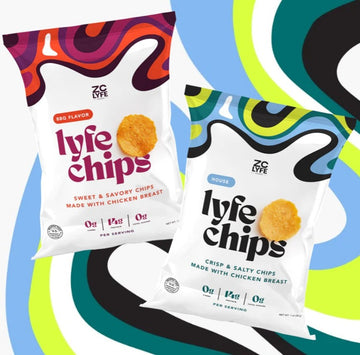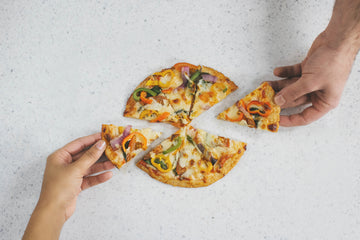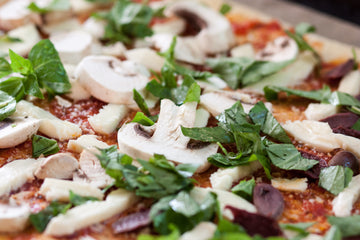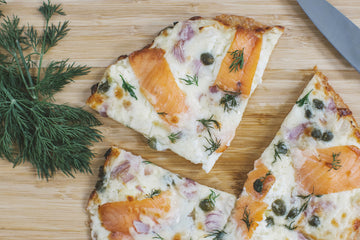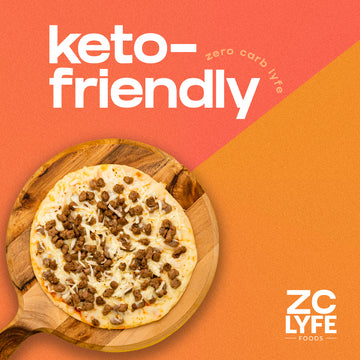
Who doesn’t love pizza? We’re sure they’re out there, but the statistics tell the real story. According to one estimate, Americans eat around 3 billion pizzas per year. That's enough to account for a full 100 acres of pizza...per day!
The fact that we eat literal tons of pizza doesn’t necessarily mean pizza always loves us back, however. Every day, pizza lovers wrestle with their cravings, trying to balance their desire for melty, delicious goodness with decidedly more practical considerations—like dietary restrictions. One study uncovered that 4 in 10 Americans are following some sort of diet, with nearly 13 million opting for strict keto programs. Many of these people quit these diets, though, indicating that a less-strict low-carb diet is the better, more sustainable approach.
Fortunately, a healthy market has emerged for alternatives to the classic, carb-loaded pizza we’ve always known. We’re talking about things like gluten free pizza crust, which lets low-carb dieters enjoy their favorite food without the worry (and discomfort).
In this article, we’re going to explore what your options are and introduce you to what makes ZeroCarb LYFE’s all-natural, zero-carb pizza crust so unique.
How Can I Eat Pizza on a Low-Carb Diet?
Pizza gets a bad rap sometimes, but you don’t actually have to choose between eating pizza and following a low-carb diet.
Let’s start with the facts, and go from there. According to USDA data, the average slice of pizza – in this case, a single slice of a 14" inch cheese pizza from a major chain – contains:
Now, if you compare that nutritional information with low-carb or even keto guidelines, which call for around 20 grams of carbohydrates per day, you’ll see that the math just doesn’t work out.
But here are a few ways you can still enjoy pizza without wrecking your diet:
If you’ve never tried making your own pizza, you totally should! Not only can you create your perfect pizza, you can avoid artificial flavors, preservatives, and other ingredients that are unhealthy and frankly unnecessary.
What Are Keto and Low-Carb Diets?
Next, it’s important to define a few dietary terms since they’re not always well-defined and aren’t interchangeable. So, what kinds of dieters will benefit most from low- or zero-carb pizza crusts? Among them are:
You can read more about each of these diets in this excellent article published by The Iowa Clinic.
It’s also worth pointing out that diabetics are interested in low-carb diets, too, as they can be effective in the management of type 1 and type 2 diabetes. What's the best pizza crust for diabetics, you ask? Popular, diabetic-friendly pizza crust options can include:
So, Can I Have a Slice of Pizza on a Low-Carb Diet?
The quick and easy answer is yes! The slightly-longer answer is that moderation is key, meaning a single slice of pizza isn’t going to undo your progress and set you back to the proverbial “Square One.” This is especially true if you balance the rest of your meal with sides like a salad made of leafy greens. And like with anything, the best and most long-lasting changes will come from the development of self-discipline, healthy/mindful eating habits, and the proper motivation.
Is Gluten-Free the Same as Low-Carb?
It’s a common misconception that gluten-free diets are the same as low-carb diets. In reality, while they overlap in some ways, these two types of diets are driven by different objectives.
Ultimately, “gluten-free does not always mean low-carb." For example, a chicken breast is naturally gluten-free and contains no carbs. Meanwhile, a sweet potato is also gluten-free but contains an average of 26 carbs. This underscores the importance of reading nutrition labels and seeking out advice and recommendations from sources you trust, like a dietician or primary care physician.
Which Pizza Crust Has the Least Carbs?
Not only is ZeroCarb LYFE’s four-ingredient pizza crust carb-free, sugar-free, and only 210 calories—it also packs in 37 grams of quality protein. That makes it the perfect pizza crust for anyone looking for a healthier option who’s not OK with sacrificing flavor.
Is Cauliflower Pizza Good for a Low-Carb Diet?
Cauliflower-based pizza is generally considered to be a healthier alternative to chain pizza, and one that’s increasingly versatile and popular. You can make your own cauliflower crust from scratch if you choose, in order to avoid artificial flavors, preservatives, and the like—or you can go for well-known frozen brands like Caulipower.
How many carbs are in Caulipower cauliflower pizza crust? A single serving of plain frozen crust (⅓ or ½ of the crust, depending on the size) contains around 32 grams of carbs. So, is cauliflower crust pizza OK on keto? Since general keto guidelines recommend 20 carbs or fewer per day, even the best cauliflower pizza crust simply has too many carbs.
Is Thin Crust Pizza Keto Friendly or Low-Carb?
If it’s made of the same general ingredients as its non-thin crust counterpart, thin crust pizza still contains a substantial amount of carbs. That being said, since there is less crust per slice, it does represent a lower-carb alternative—though it’s still not going to technically qualify as being low-carb or keto-friendly.
What Pizza Chain Has the Lowest Carbs?
This is a difficult question to answer, since there are so many variables involved, like the type of crust and its ingredients, as well as the sauce, cheese, and toppings. That being said, a handful of the major chains (see above) do offer crust-less pizza options as a way to potentially offer a lower-carb pizza.
Pizza bowls represent another lower-carb option you might find at major chains. A pizza bowl isn’t rocket science; it’s basically just everything you love about pizza served in a bowl rather than over a crust. Removing the crust (and its carbs) from the equation doesn’t guarantee a low-carb final product, though. You’ll still need to be mindful of how various sauces, cheeses, and other toppings impact the overall nutritional value.
Of the major, well-known chains, who sells crustless pizza? Let’s look at what the four leading chains offer:
Even though removing or replacing the crust does reduce the carbs, you have to be cognizant of what else is going into, or on, your pizza. If you’re not careful and load up your crustless pizza with all your favorite toppings, you still might not wind up with an especially healthy final product! Let’s explore toppings next.
What Are the Best Low-Carb Pizza Toppings?
A pizza’s crust is typically its most obvious source of carbs, followed by its sauce (often high in sugar), meaning you actually have more variety in toppings available than you might expect.
What we’re trying to say is that “low-carb” pizza doesn’t have to mean “low-flavor.” Rather, you can still have a relatively low-carb pizza without giving up your favorite proteins and veggies.
By contrast, there are only a few toppings that border on being incompatible with a low-carb lifestyle. A few toppings to avoid include those that contain a lot of sugar (like pineapple or barbeque sauce) or those with high starch content (like corn).
How Do I Make My Own Low-Carb Pizza?
Not only is making your own low-carb pizza easy, it’s also both fun and empowering. All things considered, the best way to know you’re going to get a low-carb pizza that’s actually going to taste good—and avoid artificial flavors and preservatives—is to go the DIY route.
Here are a few tips:
To get started, head to our recipes page for some innovative, mouth-watering low-carb pizza recipes. They all begin with our ZeroCarb LYFE crust, but then go in a number of different directions to accommodate any taste. Some of our favorites include:
Better Pizza, the ZeroCarb LYFE Way
At ZeroCarb LYFE, we understand how hard it can be to find low-calorie, low-carb foods that taste great, too. We quite literally wondered, “What if a low-carb crust could actually be flavorful and nutritious, not just ‘good enough’?”
Our four-ingredient, protein-based crust isn’t just low-carb, it’s carb-free. It’s also gluten-free, diabetic-friendly, and keto-friendly. Pizza night just got a lot more exciting for those who are looking to cut carbs, improve their eating habits, or just feel great about what is fueling their bodies. Order a pack of our crusts today, or explore our range of flavor-packed frozen pizzas. Happy eating!

